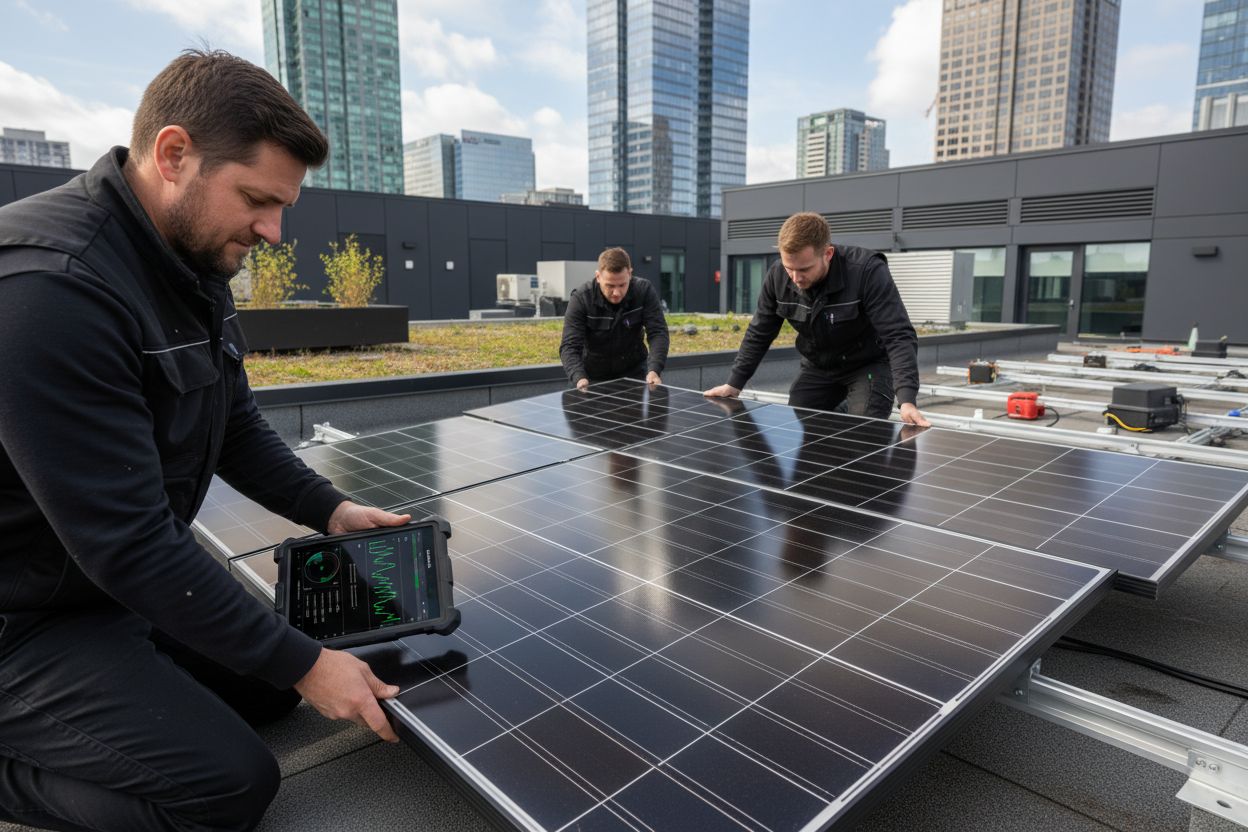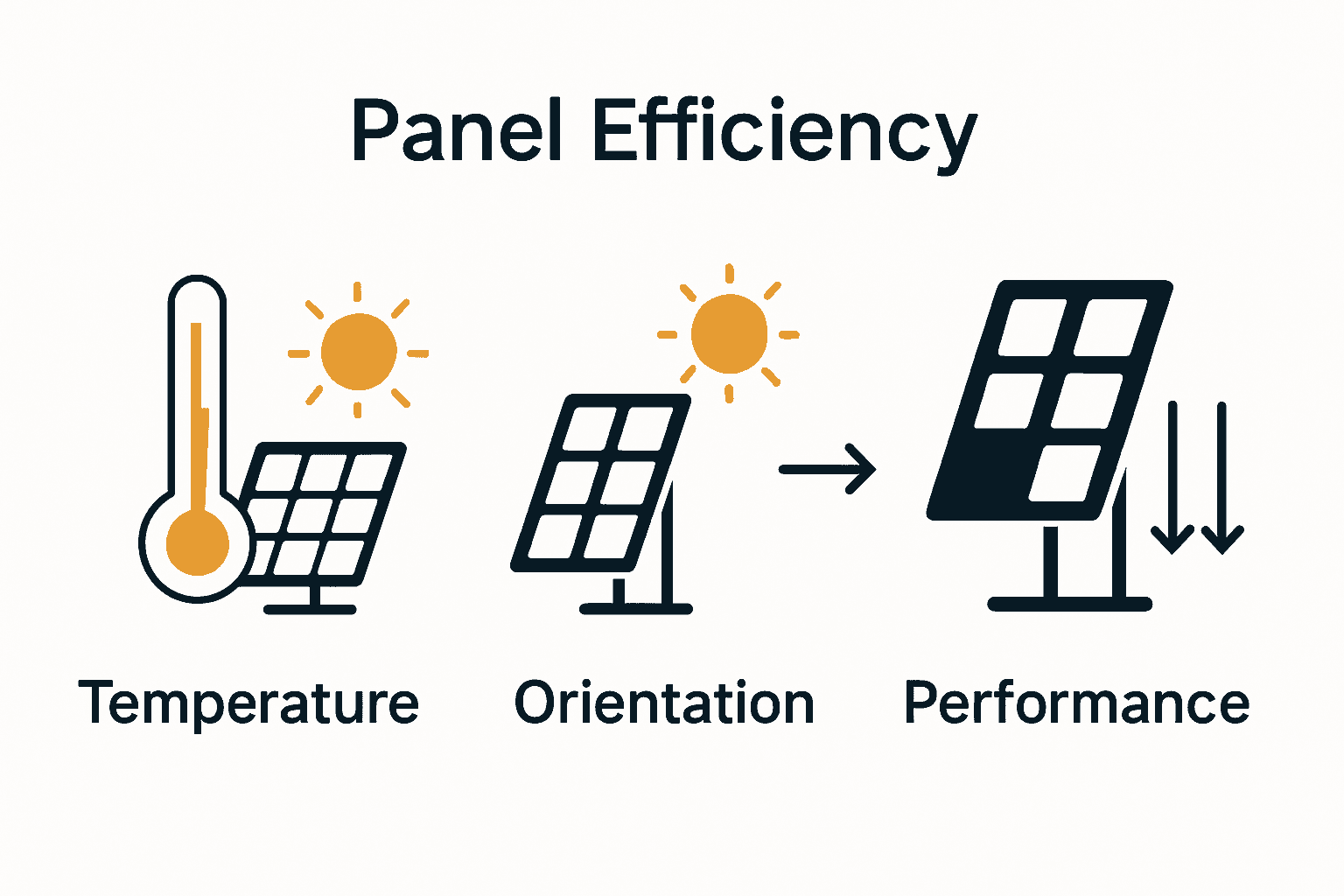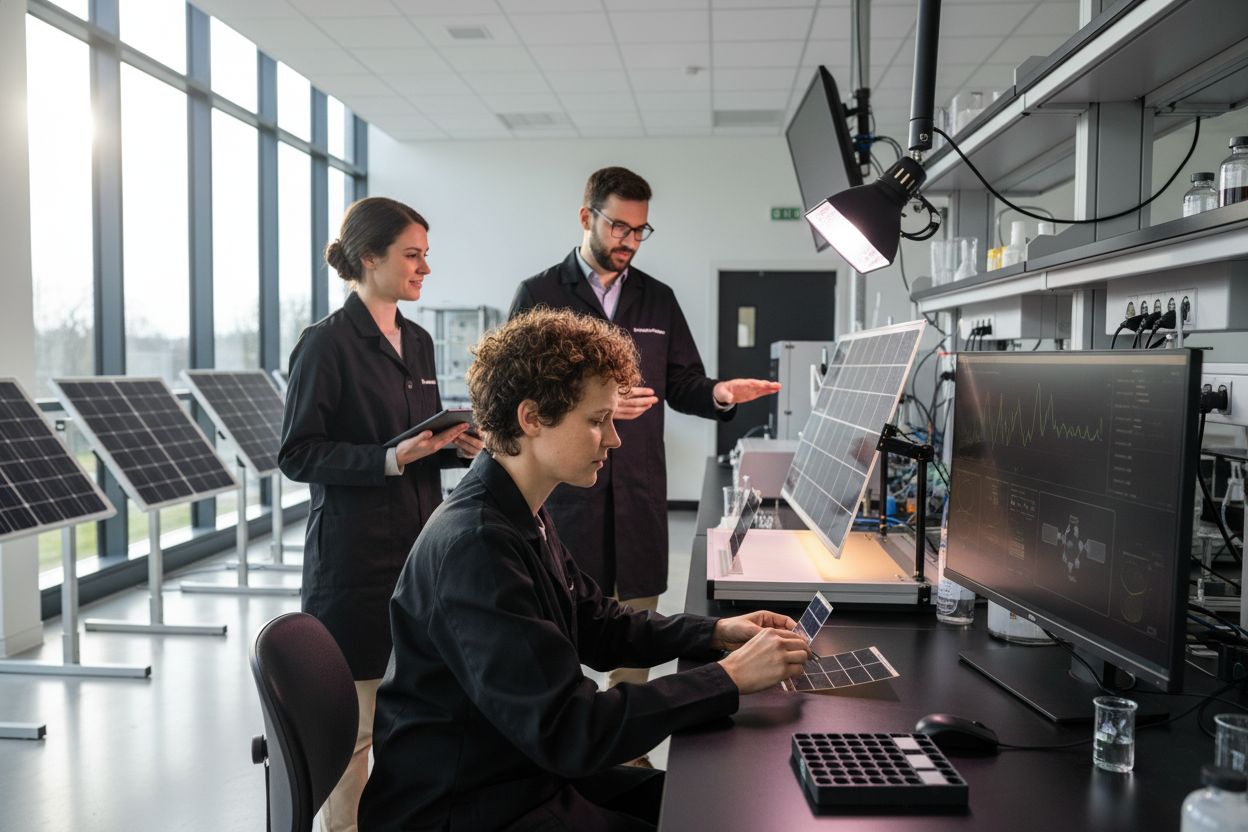
Did you know that some of the latest solar panels now reach an impressive 28.6% efficiency, shattering expectations from just a decade ago? Solar power has transformed from a niche option to a mainstream energy solution, yet myths about its efficiency still linger. Debunking these misconceptions reveals a fast-moving field where science and innovation continuously raise the bar, helping homeowners and businesses make smarter energy choices for a more sustainable future.
Key Takeaways
| Point | Details |
|---|---|
| Solar Panel Efficiency Is Dynamic | Efficiency is influenced by various factors such as temperature, orientation, and shading. Ongoing innovations continue to challenge previous efficiency limits, leading to increased performance. |
| Types of Solar Panels Vary Significantly | Monocrystalline panels lead the market with 20-25% efficiency, while polycrystalline and thin-film options offer trade-offs in cost and performance. Selecting the right type depends on specific installation needs. |
| Technological Advances Are Key | Breakthroughs like perovskite-silicon tandem and heterojunction cells are pushing efficiency ratings beyond traditional limits, improving energy generation in constrained spaces. |
| Solar Competes Well Against Other Power Sources | While solar efficiency may seem lower than fossil fuels, its environmental benefits and decreasing costs present a compelling case for adoption in energy generation. |
Table of Contents
- Defining Solar Panel Efficiency And Myths
- How Solar Panels Convert Sunlight To Power
- Types Of Solar Panels And Efficiency Ratings
- Key Factors Affecting Efficiency Performance
- Comparing Efficiency To Other Power Options
Defining Solar Panel Efficiency and Myths
Solar panel efficiency isn’t just another tech buzzword—it’s the critical measure of how much sunlight a panel can convert into usable electricity. Solar panel efficiency represents the percentage of solar energy hitting a panel that gets transformed into electrical power. Think of it like a superhero’s power conversion rate: how much potential energy gets turned into actual, workable energy.
Traditionally, researchers believed solar panels had strict efficiency limitations. According to the Shockley–Queisser limit, single-junction solar cells could theoretically reach a maximum efficiency of around 30% under standard solar spectrum conditions. But recent technological breakthroughs are shattering these long-held myths. For instance, our guide on solar panel technologies reveals how innovative approaches are pushing these boundaries.
Some persistent myths about solar panel efficiency include:
- Solar panels are too inefficient to be worthwhile
- Efficiency never improves
- All solar panels perform identically
Reality tells a different story. As reported by Reuters, companies like Qcells are achieving remarkable milestones—recently breaking records with a 28.6% efficiency in perovskite-silicon tandem solar cells. These advancements demonstrate that the solar industry is constantly evolving, challenging previous assumptions about technological limits.
Understanding solar panel efficiency means recognizing it’s not just about raw numbers, but about continuous innovation. Each percentage point of increased efficiency represents more electricity generated, lower installation costs, and a significant step toward sustainable energy solutions.
How Solar Panels Convert Sunlight to Power
Photovoltaic conversion might sound like complex science, but at its core, it’s a remarkable dance between sunlight and semiconductor materials. When photons from sunlight strike a solar panel, they interact with specially designed layers of silicon or other semiconductive materials, creating an electric field that generates direct current (DC) electricity. Our guide to solar panel setup offers deeper insights into this fascinating process.
The magic happens at the atomic level. Solar cells are constructed with two different types of silicon—one positively charged (p-type) and one negatively charged (n-type). When sunlight hits these layers, electrons are knocked loose from their atoms, creating an electrical current. According to research on multi-junction solar cells, advanced designs can stack multiple semiconductor layers tuned to different wavelengths, dramatically improving energy conversion potential.
Key stages of solar energy conversion include:
- Photon absorption by semiconductor material
- Electron displacement creating electrical potential
- Electron flow through electrical circuit
- Conversion of direct current to usable alternating current
Cutting-edge technologies are pushing efficiency boundaries. Heterojunction (SHJ) cells represent a significant breakthrough, combining different silicon structures to achieve superior surface passivation. As research indicates, these advanced cells can reach commercial efficiencies around 25%, representing a substantial improvement over traditional solar panel designs. The future of solar energy looks bright—quite literally—as scientists continue developing more sophisticated methods of capturing and converting solar radiation into clean, renewable electricity.
Types of Solar Panels and Efficiency RatingsUnderstanding solar panel types is like exploring a technology buffet—each option offers unique advantages and efficiency levels. Monocrystalline panels currently dominate the market, comprising nearly 98% of global shipments in 2023, with impressive efficiency ratings between 20–25%. Our comprehensive guide to solar panel types can help you navigate this complex landscape.
The solar panel ecosystem includes several distinct technologies, each with its own performance characteristics:

- Monocrystalline Panels: Premium single-crystal silicon design
- Polycrystalline Panels: More affordable, slightly lower efficiency
- Thin-Film Panels: Flexible and lightweight alternatives
According to recent solar technology research, efficiency varies dramatically across panel types. Polycrystalline panels typically deliver 15–17% efficiency, while thin-film technologies like CIGS or CdTe achieve 10–17% conversion rates. Advanced technologies such as Heterojunction (HJT) and Interdigitated Back Contact (IBC) panels push boundaries, exceeding 23% efficiency.
Choosing the right solar panel isn’t just about raw numbers—it’s about matching technology to specific environmental and spatial constraints. Monocrystalline panels excel in space-constrained installations, offering maximum power generation in minimal area. Thin-film panels, while less efficient, provide unique advantages in flexible applications like curved surfaces or portable solar solutions. The solar panel market continues evolving, with ongoing research promising even more sophisticated and efficient technologies in the near future.
Here’s a comparison of common solar panel types and their typical efficiency ratings:
| Panel Type | Efficiency Range | Key Advantages |
|---|---|---|
| Monocrystalline | 20–25% | High efficiency Space saving |
| Polycrystalline | 15–17% | Lower cost Moderate performance |
| Thin-Film | 10–17% | Lightweight Flexible use |
| HJT/IBC Advanced | 23%+ | Cutting-edge Superior performance |
Key Factors Affecting Efficiency Performance
Solar panel efficiency isn’t a static number printed on a datasheet—it’s a dynamic measurement influenced by multiple real-world variables. Performance metrics are typically measured under standard test conditions (STC), but actual energy generation can fluctuate dramatically based on environmental and technological factors. Our detailed guide on understanding solar panel performance provides deeper insights into these complex interactions.
Key factors impacting solar panel efficiency include:

- Temperature: Higher temperatures reduce electrical output
- Panel orientation: Direct sunlight exposure maximizes generation
- Shading: Even partial shade can significantly decrease performance
- Panel age: Gradual degradation reduces efficiency over time
Recent technological breakthroughs are addressing these challenges head-on. According to Reuters, Trina Solar’s achievement of a 25.44% efficiency record for heterojunction (HJT) modules demonstrates how advanced surface passivation techniques can directly improve real-world panel performance. This means smaller installation areas can generate more electricity, a critical advancement for urban and space-constrained environments.
Understanding efficiency isn’t just about peak performance—it’s about consistent, reliable energy generation. Modern solar technologies are developing sophisticated solutions like anti-reflective coatings, improved semiconductor structures, and intelligent tracking systems that adapt to changing environmental conditions. These innovations promise not just higher efficiency ratings, but more predictable and stable energy production across diverse real-world scenarios.
Comparing Efficiency to Other Power OptionsWhen discussing power generation, solar efficiency tells only part of the story. Different energy technologies offer unique advantages, with solar panels increasingly becoming competitive against traditional power sources. Our comprehensive guide on energy efficiency can help contextualize these comparisons.
Comparative efficiency across power generation technologies reveals fascinating insights:
- Coal Power: 33–40% efficiency
- Natural Gas: 40–60% efficiency
- Nuclear: 33–37% efficiency
- Solar Photovoltaic: 15–25% efficiency
- Wind Turbines: 35–45% efficiency
Research highlights interesting nuances in solar technology. According to CSIRO, lightweight printed solar cells have achieved up to 15.5% efficiency—significantly lower than traditional silicon panels, but offering unprecedented portability and low deployment costs. Thin-film technologies like CdTe or CIGS, while featuring lower efficiencies (10–20%), demonstrate exceptional performance in specific contexts such as flexible installations or utility-scale projects.
The efficiency comparison goes beyond raw numbers. Solar power’s primary advantages include zero direct emissions, minimal maintenance requirements, and continuously decreasing installation costs. While solar panels might have lower immediate efficiency compared to fossil fuel alternatives, their long-term environmental and economic benefits create a compelling argument for widespread adoption. Technological innovations are rapidly closing efficiency gaps, making solar an increasingly attractive power generation option for both small-scale and industrial applications.
Turn Solar Insights Into Action With HTEXS
You have just learned how solar panel efficiency influences everything—from the amount of power you generate to the real savings you see. Still, it can be difficult to interpret technical terms like photovoltaic conversion or compare rating numbers when making a purchase. You want technology that truly delivers value, but you face uncertainty when it comes to selecting the best solutions for your space and needs. Frustration grows if you feel overwhelmed by shifting technical standards or skeptical claims. This is where accurate product reviews, helpful guides, and reliable tips make all the difference. Find smart, honest advice for your next solar solution in our Tips And Techniques section.

Ready to identify the most efficient solar panels for your home or business? Browse up-to-date reviews and clear, step-by-step advice at HTEXS. See how you can apply the ideas from this article and stay ahead of new technology trends by joining a trusted tech community now. The best way to maximize your solar investment starts with actionable information—visit us, get expert help, and move towards a brighter, more efficient future today.
Frequently Asked Questions
What is solar panel efficiency and why is it important?
Solar panel efficiency is the percentage of sunlight that a solar panel can convert into usable electricity. Higher efficiency means more energy is produced from the same amount of sunlight, leading to lower installation costs and increased energy generation.
How do different types of solar panels compare in terms of efficiency?
Monocrystalline panels are the most efficient, typically achieving 20-25% efficiency. Polycrystalline panels follow with 15-17% efficiency, while thin-film panels have the lowest efficiency, ranging from 10-17%. Advanced technologies like Heterojunction and Interdigitated Back Contact panels can exceed 23% efficiency.
What factors can impact the efficiency of solar panels?
Key factors affecting solar panel efficiency include temperature (higher temperatures can reduce output), panel orientation (optimal sunlight exposure is crucial), shading (even partial shade can lower performance), and the age of the panel (efficiency can degrade over time).
Are solar panels becoming more efficient over time?
Yes, continuous advancements in solar technology are improving efficiency. Recent innovations, such as perovskite-silicon tandem solar cells and heterojunction cells, are achieving record efficiencies and are pushing the boundaries of what is possible in solar energy conversion.






